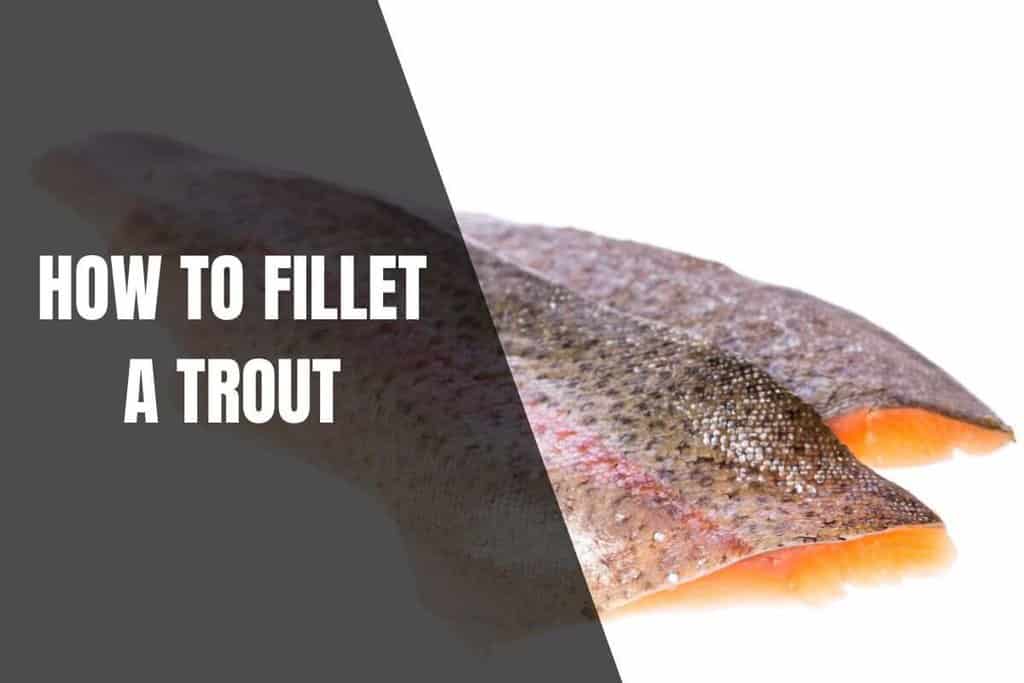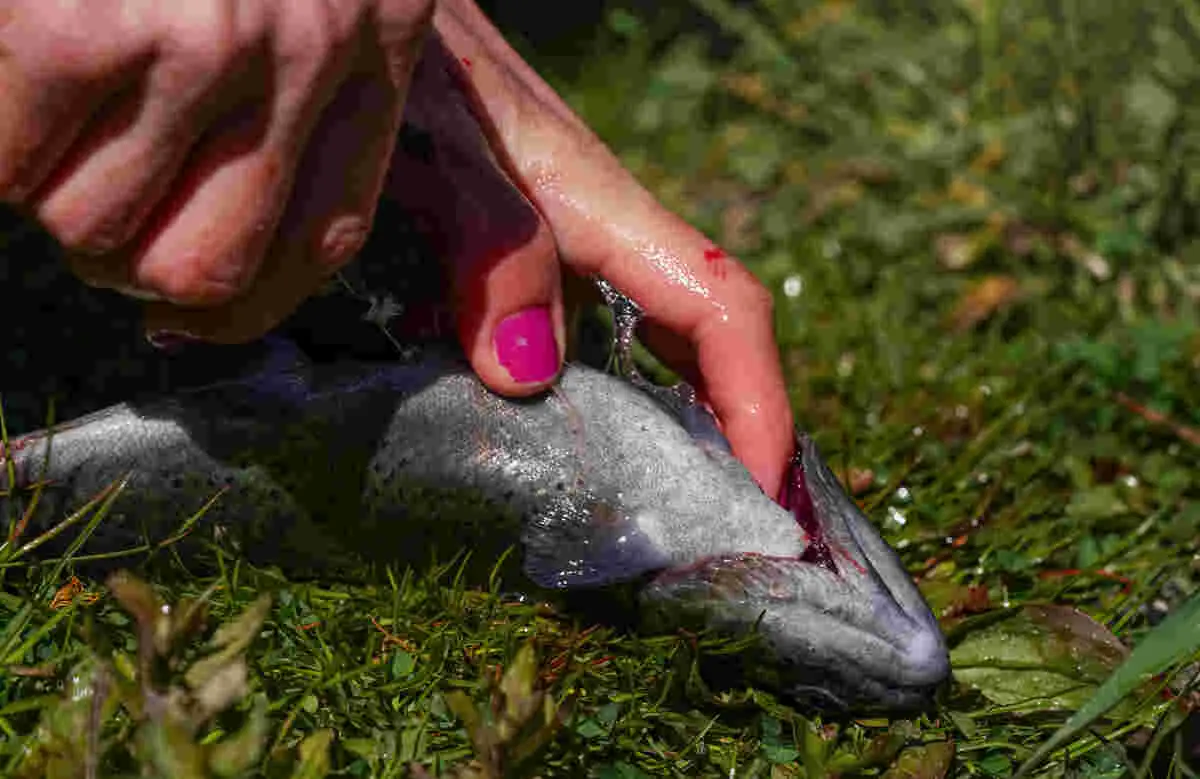Knowing how to fillet trout is a valuable skill, and it will come in handy if you ever have to clean your catch. Filleting is an excellent way to show off your skills at the grill for friends and family members. However, filleting a trout can be challenging in home cooking if you don’t know what you’re doing.
First, you’ll have to gut the trout. Using a filleting knife, remove the scales, beginning at the tail, and work your way up the body before rinsing the trout with cold water. Next, cut down the length of the spine from behind the gills to just before the tail – ending up with two complete fillets.
Filleting trout is a skill everyone should know, though not everyone will find it as helpful or exciting as a fisherman. Nonetheless, filleting is one of those things that seems simple on the surface but can be more challenging to master than you realize.

In this post, we will walk through all the steps you need to do when filleting a trout.
How To Fillet a Trout
Trout are more manageable to fillet than most other types of fish because they’re not as tied into their muscle structure. This looser connective tissue makes them easier to cut into thin pieces.
Trout is one of the easiest fish to fillet, but it’s not always easy to get a good result. Follow these tips for an easy, clean job:
- Cut off the trout’s head. Cut the fish’s spine closest to its head using scissors or a sharp knife. Follow through until the head is completely off. Set the head aside as it’s great to use to make fish stock.
- Make an incision through the trout’s neck and cut along its spine. With a sharp knife, slice gently along the rib from the trout’s head to its tail, ensuring the blade is as close to the bone as possible. You’re pulling the fillet away from the bone by placing the knife between the meat and rib. Flip the fish and repeat this process to get your second fillet. Discard the spine and tail.
- Remove the dorsal fins of each fillet. Create an incision at the top of each fillet at the fin. Then pull the dorsal fin out.
- Clean up your fillet. Trim the belly and fat to ensure the fillet looks clean and is ready for cooking. Then, get ready to remove all the pin bones from your fish.
To assist you, here is a great video explaining the ins and outs of filleting a trout:
Should You Fillet a Trout?
If you’re not careful while cooking trout, you can have a challenging meal on your hands. The answer? You have to fillet it!
Trout is a fish that often has a bad reputation. People mistakenly believe it to be bland and flavorless because it’s generally sold whole, with the skin and bones intact. You may lose the fish’s subtle flavor when you cook it in this state.
You should fillet a trout before cooking it so that you can let the delicate flavor of the trout shine through. You cut the fillets from the center of the trout’s body, where all the oil and flavor are stored, so they’re both higher in fat and lower in bones than trout still in their complete form.
Filleting a trout will turn one of the less expensive meats in the grocery store into something that rivals what you’d get at a high-end restaurant. It’s an easy task to do and only takes a few minutes.
Are Trout Easy To Fillet?
Trout are easy to fillet if you know the correct procedure. You need to ensure your knife is sharp and to cut from the gills to the tip of the tail. However, removing pin bones can take some practice.
Trout filleting is made a lot easier by knowing what pin bones are. Pin bones are delicate, tiny bones that will become visible in the meat once you have cut your fillet.
Pin bones run through the fillet like a series of delicate rays and can be as small as a hair. These tiny bones are responsible for many people’s inability to fillet trout properly, so getting rid of them is your priority once you’ve got your fillets.
On the other hand, the great news is that it’s easy to remove pin bones if you know what you’re doing.

Do You Have To Gut a Trout Before You Fillet It?
You should always gut a trout before you fillet it because you want to ensure that the fish doesn’t come into contact with bacteria while cooking. Gutting a trout is an easy but essential step in preparing it for cooking. The process is simple, and anyone with basic kitchen skills can succeed.
The first step to filleting a trout is to clean it. Gutting is an essential part of the cleaning process. To do this, you’ll need:
- A cutting board
- Sharp knife
- Cool water
Here are some simple steps to follow when gutting your trout:
- Descale the fish. Scrape the backside of the knife along the trout’s body from the tail to the head on both sides of the fish until it creates a smooth skin surface.
- Place the fish on the cutting board. It would be best if you placed the fish in a way that its belly faces you.
- Create an incision on the tail’s underside (near the anus). Continue to cut through the middle of the fish until you reach the trout’s head.
- Take the guts out. Pull out the gills, remove their entrails through the opening, and discard them.
- Rinse your fish with cold fresh water. This rinsing will remove blood or entrail leftovers.
- Remove the mud line. Use your finger to work from the tail towards the head; remove the mud line, which you will find near the spine.
After completing these steps, you’ll be on your way to filleting your trout. To further assist you, here is a great video demonstrating this process:
How To Remove Trout Pin Bones
Trout fillets are an excellent choice for the home chef because they’re quick to prepare, easy to cook, and make a delicious presentation when served. However, it’s important to remember to remove the pin bones after you’ve filleted your trout.
Pin bones are tiny, long, and thin bones that run through the fillet of your trout. They’re small but can make for an unpleasant surprise during your meal. Removing these bones from a fresh fillet is a delicate endeavor because the bones do not release them willingly.
If you use your hands to remove pin bones, you risk tearing your beautiful fillet, making it far less appealing. It would be best if you utilized Fish Bone Tweezers from Amazon to assist you throughout this process.
Below are some steps to help you remove the pin bones from your fillet:
- Lay your fillet down on a cutting board. The skin should be on the surface of the board.
- Locate the bones. Run your fingers along the fillet, feeling for any bones. You will often find them along the thickest part of the fillet. Then, lightly press down on the fillet—you’ll notice the lines of pin bones protruding from the flesh.
- Use your tweezers to grasp the tip of the bones. Once you’ve pulled out one, continue to feel for others and pull them out until they’re all gone. Be sure to pull out the bones at an angle softly.
There you have it. After removing the pin bones, you’ll have the perfect bone-free trout fillet ready to be cooked for a delicious meal.
Fish Descaling Tool
Descaling a fish does not have to be complicated. You can simply use your filet knife to descale a fish but for some the idea of potentially cutting your hand does not sit right with them. That’s where using a descaling tool comes in handy! There is a low risk of injury.
Fish Pin Bone Tweezers
Pin bones are extremely annoying to deal with, especially if you find them in your mouth as you are eating. You can remove these pin bones by simply slicing the row of pin bones off your fillet, but you will lose precious meat. You can pluck them using your fingers, but you ruin the fillet by digging your fingers in the meat to get the bones. Save yourself the headache and just use some good quality tweezers!
How To Fillet a Trout FAQs
Is It Better to Debone Trout Before or After Cooking?
It is better to debone a trout after cooking because the cooking process loosens the tendons and tissues and allows the fish to flake off the bone. The bone is also vital to the cooking process as it imparts much of the trout’s rich flavor into the flesh.
Should You Remove Skin From a Fillet?
You should not remove the skin from a trout fillet as it crisps up beautifully when frying or grilling and imparts more flavor into the fish. The skin also contains nutrients that can help improve heart and skin health.



